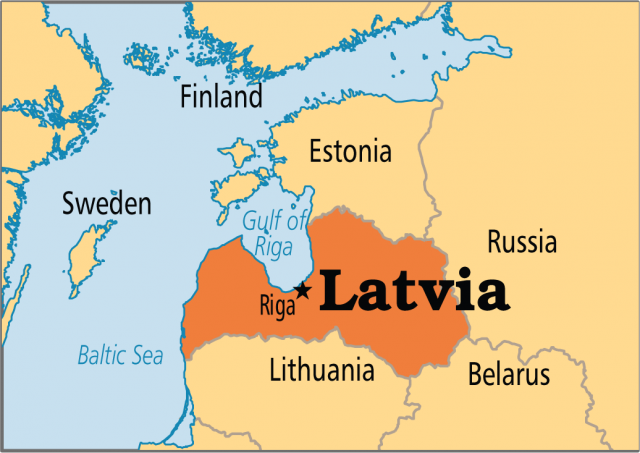Latvia
Area 24,937 square mi (64,589 square km)
Population 1.990 million 2014
Capital Riga
Highest Point Gaizinkalns 1,017 ft (311 m)
Lowest Point 0 m
GDP $31.92 billion 2014
Primary Natural Resources peat, limestone, dolomite, amber.
ON THE EASTERN shore of the Baltic Sea in northern Europe, the Republic of Latvia is a flat country that borders ESTONIA to the north, LITHUANIA to the south, BELARUS to the southeast, and RUSSIA to the east. Latvia is a parliamentary democracy with the supreme council, or Saeima, serving as the legislature and a president as head of state.

Most of Latvian topography is a flatland consisting fields, forest, lakes, marshes, and navigable rivers, with the exception of small hills east of Riga and to the southeast. Its chief rivers are the Daugava, Guja, Venta, and Lielupe. The major cities in Latvia are Riga, Daugavpils, Liepaja, and Jurmala. The country is marked by a long coastline indented by the Gulf of Riga to the northwest and some natural harbors. The climate is humid with only 30 to 40 days of sunshine per year. Temperatures range from 28 degrees F (-2 degrees C) in January to 63 degrees F (17 degrees C) in June.
The first permanent human settlements in what is know Latvia date at least to 9000 B.C.E. by migrations from the south and the southwest. From the 12th century onward, Latvia transferred from the rule of the Teutonic Knights, to the Poles, to the Swedes, and to the Russians. A Latvian national consciousness was formed by the early 19th century by its intellectuals, later to be transformed into an independence movement. Russian military weakness in World War I provided the opportunity for Latvia to gain independence in 1920.
The fledgling republic was beset by conflicts between fascists on the right and communists to the left. In June 1940, Latvia was occupied by the Soviet Union and later invaded by Nazi Germany. In 1944, Latvia was reoccupied by the Soviet Union and incorporated as a Soviet republic after World War II. In 1991, Latvia gained its independence from the Soviet Union and, with its neighbors Lithuania and Estonia, did not join the Commonwealth of Independent States, which arose from the demise of the Soviet Union. The last Soviet troops withdrew from Latvian soil in August 1994. Latvia became a member of the EUROPEAN UNION in May 2004.
Latvians or Letts make up 54 percent of the population. The next largest groups include Russians, Belarussians, Ukrainians, and Poles. Incorporating its Russian minority poses a challenge for the new Latvian society, still bitter over Soviet and earlier occupations.
Latvia's fastest-growing exports are in the fields of biotechnology, pharmaceuticals, and timber, the country remains heavily dependent on energy, particularly from Russia. Independence from the Soviet Union also meant the start of a free-market economy. Despite hardships caused by economic reform, Latvia has been generally successful in emerging as an independent state.